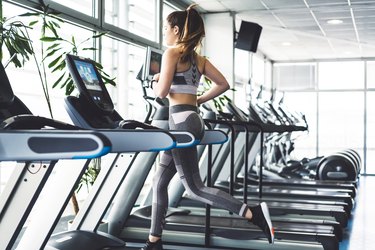
Treadmills allow you to walk, jog or run, depending on your fitness goals. The faster you go, the more calories you burn, and the more impact you create in your workouts. Your physical condition — more than your age — should guide you as you select treadmill speeds.
Younger children will be less concerned with impact than seniors and will be better able to withstand the effects of higher speeds. Start slow and build your ability to use a treadmill at higher speeds as you improve your physical condition.
Video of the Day
Video of the Day
Tip
Your age and physical condition will be the greatest determiners of how fast you should go on a treadmill.
Age 5 and Under
Treadmills pose significant safety risk to children age 5 and under, according to Nationwide Children's. Surprisingly, most injuries occur to the upper body for this age group, especially their hands.
Use treadmills at a very slow speed with children this age and provide close supervision by having an adult present.
Read more: How Long Should Someone Run on a Treadmill
School-Age Children and Teens
The Physical Activity Guidelines for Americans recommends children of ages 6 to 17 get at least an hour of aerobic exercise/activity/sports each day — and muscle and bone-strengthening activities at least three times a week.
Depending on your child's physical condition, he should start slow to build cardiovascular stamina. When he's ready to perform aerobic exercise, he should use a treadmill at a pace that has him breathing hard and sweating, but able to talk throughout the workout.
Treadmill Usage for Adults
Adults should use similar treadmill speeds to school-age children and teens, depending on their cardiovascular fitness and any knee, back or other joint or muscle problems.
If you're new to exercise, consider using a treadmill below 4 mph as you work to build cardiovascular stamina. While you get in shape, you can walk at a brisk pace to burn fat and improve aerobic conditioning.
When you are ready to do aerobic exercise, use the treadmill at 3 to 5 mph or higher, depending on your height and gait, to create a pace you can maintain during your entire workout.
Well-conditioned athletes can add interval training to their workouts, says Harvard Health Publishing, running fast for one minute, with three minutes of slower walking or jogging afterward. These speeds assume a flat incline — a higher incline will be more difficult.
Seniors, Protect Your Bones
Osteoporosis is a key concern for seniors, especially women, according to the National Osteoporosis Foundation. Almost half of all senior women will experience a fracture, with approximately 20 percent of senior men breaking a bone.
Using a treadmill at high speed will cause both feet to leave the ground, creating high-impact workouts that can cause stress fractures. Weight-bearing exercises, such as walking, help improve bone density.
Seniors should use a treadmill at a speed that lets them keep both feet on the treadmill during their workout. To increase calorie burning, consider using walking poles during your workout.
- Health.gov: "Dietary Guidelines for Americans, 2015-2020"
- Nationwide Children's: "Understanding the Dangers of Treadmills"
- Health.gov: “Physical Activity Guidelines for Americans, 2nd Edition”
- Harvard Health Publishing: "Get Smart About Treadmills"
- National Osteoporosis Foundation: "Did You Know That Weak Bones Are Not a Normal Part of Aging?"